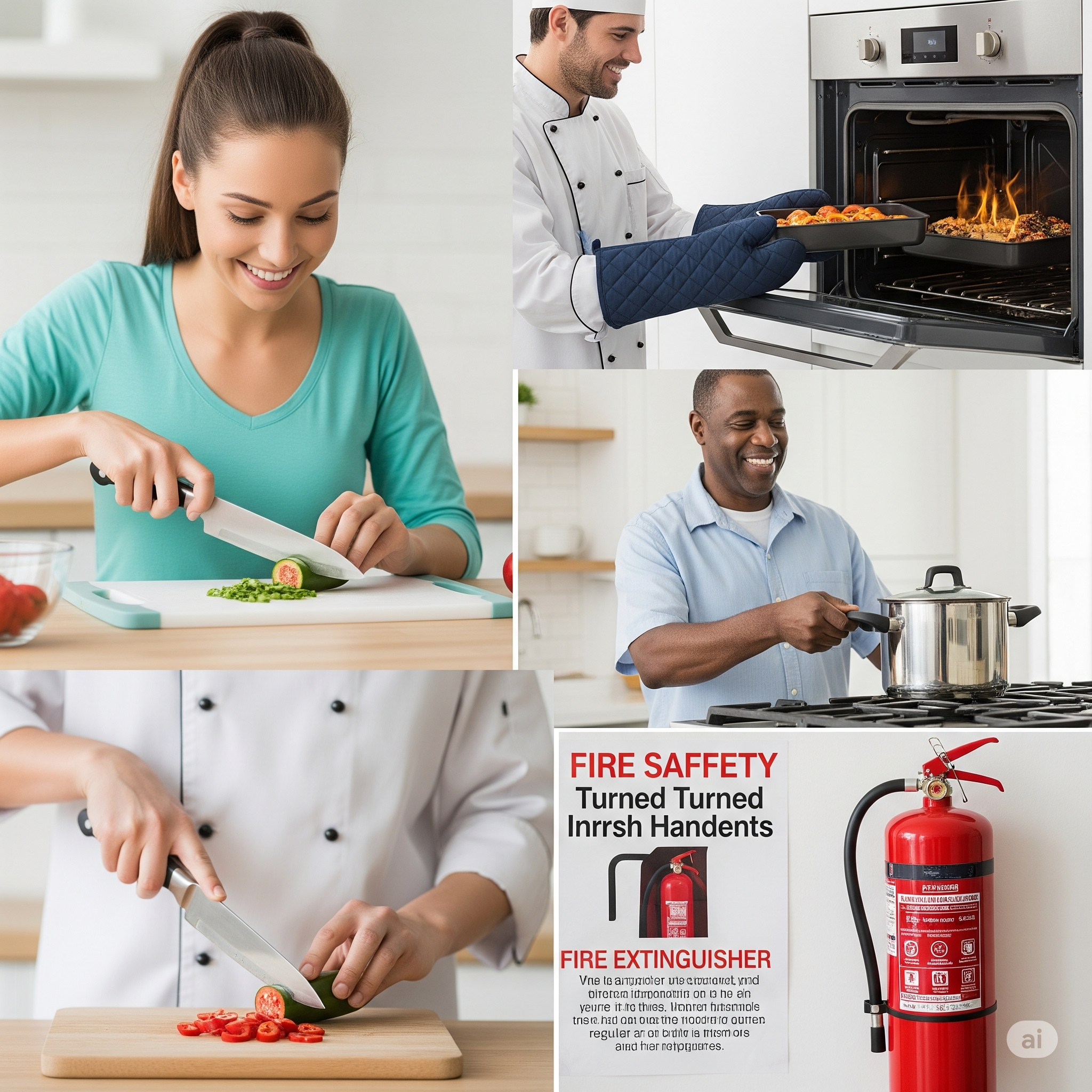The kitchen is often described as the heart of the home – a vibrant space for cooking delicious meals, gathering with family, and creating lasting memories. However, with its combination of open flames, intense heat, sharp objects, and electrical appliances, it can also be the most hazardous room in the house if proper precautions are not taken. Prioritizing kitchen safety is essential for preventing accidents, from minor cuts and burns to serious fires, and for ensuring a healthy environment for everyone.
This comprehensive guide provides essential kitchen safety tips that every household should practice.
1. Fire Prevention: Your Top Priority
Kitchen fires are a leading cause of residential fires globally. Vigilance is your best defense.
- Never Leave Cooking Unattended: This is the most critical rule. If you must step away from the kitchen, even for a moment, turn off the stove burner.
- Keep Flammable Items Away from Heat: Ensure that dish towels, paper towels, oven mitts, food packaging, and curtains are a safe distance from your cooktop and oven.
- Clean Grease Buildup: Grease is highly flammable. Regularly clean your stovetop, oven, and especially the filter in your range hood to prevent a grease fire.
- Handle Grease Fires Correctly:
- NEVER use water. It will cause the flaming oil to splash and spread the fire.
- Smother the flames. For a small fire in a pan, carefully slide a lid over it to cut off the oxygen and turn off the heat source. Leave the lid on until the pan has completely cooled.
- For larger fires, evacuate immediately and call emergency services.
- Have a Fire Extinguisher Ready: Keep a suitable fire extinguisher (Class K for kitchen fires is ideal, or a multi-purpose Class ABC) in an accessible location and ensure all responsible adults know how to use it (P.A.S.S. method: Pull, Aim, Squeeze, Sweep). Check its expiry date and pressure gauge regularly.
- Maintain Smoke Detectors: Install smoke alarms near the kitchen, but not so close that normal cooking steam will trigger false alarms. Test them monthly.
- Watch Your Clothing: Avoid wearing loose-fitting clothes with long, dangling sleeves that could catch fire.
2. Preventing Burns: Handle with Care
Burns from hot surfaces, liquids, and steam are common kitchen injuries.
- Use Dry Oven Mitts: Always use thick, dry oven mitts or pot holders when handling hot cookware. Wet mitts can transfer heat quickly.
- Open Lids Carefully: Lift the lid of a hot pot away from your face to allow steam to escape safely and prevent a painful steam burn.
- Turn Pot Handles Inward: Position pot and pan handles towards the back or center of the stovetop. This prevents them from being accidentally knocked over, a crucial tip for households with children.
- Establish a “Kid-Free Zone”: Keep young children and pets at least 3 feet (about 1 meter) away from the stove and oven while cooking.
3. Knife Safety & Cut Prevention
Sharp knives are essential tools but demand respect and proper handling.
- A Sharp Knife is a Safe Knife: Dull knives require more pressure to cut, increasing the chance of slipping. Keep your knives properly sharpened.
- Use a Stable Cutting Board: Always cut on a secure cutting board. If it slides, place a damp paper towel or cloth underneath it for stability.
- Cut Away From Your Body: Always direct the knife’s edge away from your body and fingers.
- Store Knives Safely: Use a knife block, a wall-mounted magnetic strip, or an in-drawer knife organizer. Never leave sharp knives loose in a drawer.
- Never Try to Catch a Falling Knife: Step back and let it drop.
- Wash Knives Separately: Don’t place sharp knives in a sink full of soapy water where they are hidden from view. Wash them carefully one at a time.
4. Preventing Slips, Trips, and Falls
- Clean Up Spills Immediately: Water, grease, or food on the floor creates a serious slip hazard. Clean it up right away.
- Keep Floors Clear: Ensure floors are free of clutter, such as bags, boxes, or children’s toys, that could cause a trip.
- Use Non-Slip Mats: Place mats with a non-skid backing in areas prone to wetness, like in front of the sink.
5. Electrical and Gas Safety
- Keep Appliances Away from Water: Water and electricity are a dangerous combination. Never operate electrical appliances with wet hands or near a full sink.
- Don’t Overload Outlets: Avoid using multi-plug adaptors for high-power appliances like microwaves or kettles.
- Check Cords: Regularly inspect appliance cords for any signs of fraying or damage and replace if necessary. Unplug small appliances when not in use.
- Gas Safety (Especially with LPG): For households using LPG gas cylinders, common in Indonesia:
- Check Connections: Ensure the regulator and hose are securely fitted and check for leaks or wear periodically.
- If You Smell Gas: Immediately extinguish any open flames, open all windows and doors for ventilation, do not operate any electrical switches, and turn off the gas supply at the cylinder regulator if safe to do so. Evacuate and call for help from outside.
- Ensure Ventilation: Always have some airflow when using a gas stove.
6. Food Safety & Hygiene
Preventing foodborne illness is a key part of kitchen safety, especially in warm climates where bacteria multiply quickly.
- Wash Hands Thoroughly: Before, during, and after handling food, especially raw meat, poultry, and eggs.
- Avoid Cross-Contamination: Use separate cutting boards, knives, and utensils for raw meats and ready-to-eat foods like vegetables and fruits.
- Cook to Safe Temperatures: Use a food thermometer to ensure meats are cooked to the correct internal temperature.
- Refrigerate Promptly: Store perishable foods in the refrigerator within two hours (or within one hour if the ambient temperature is high).
7. Childproofing the Kitchen
- Active Supervision: Never leave young children unattended in the kitchen.
- Secure Hazards: Keep knives, cleaning supplies, and matches in high cupboards or secured with childproof latches.
- Use Back Burners: Whenever possible, cook on the back burners of your stove to keep hot pots and pans further from children’s reach.
Conclusion
A safe kitchen is the foundation of a happy and healthy home. By cultivating mindfulness, practicing proper techniques, and being prepared for emergencies, you can significantly reduce the risks of accidents. Make these essential safety tips a habit for every member of your household to ensure your kitchen remains a place of nourishment, creativity, and well-being.







Leave a Comment